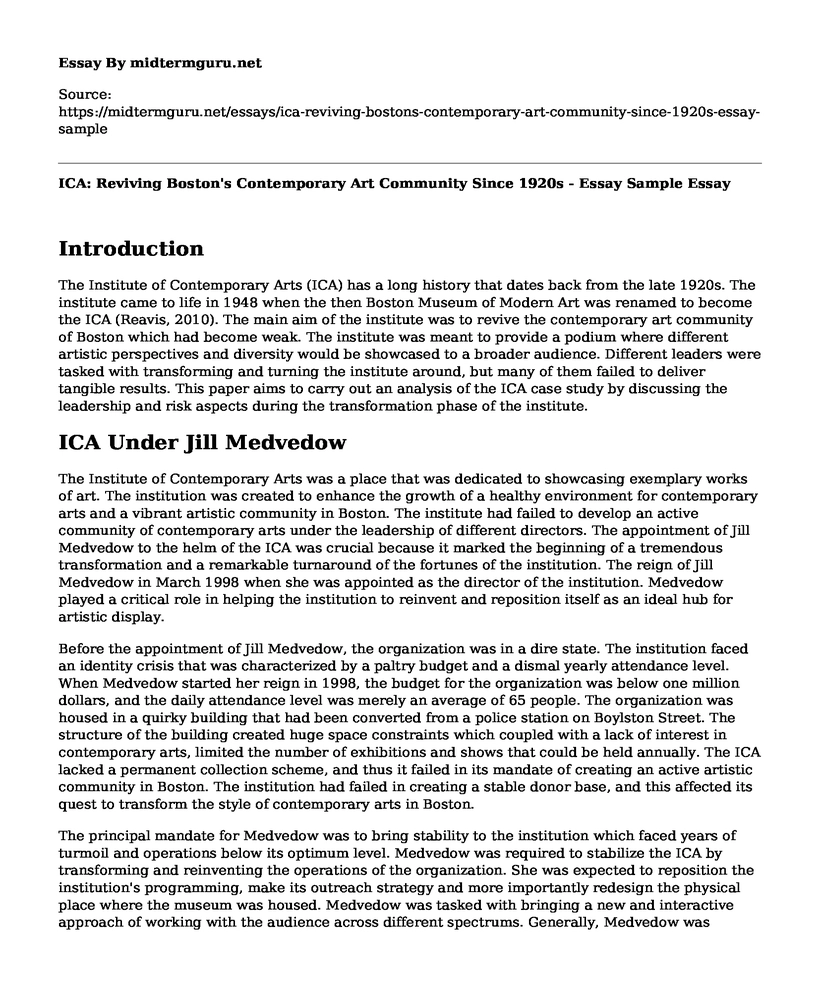Introduction
The Institute of Contemporary Arts (ICA) has a long history that dates back from the late 1920s. The institute came to life in 1948 when the then Boston Museum of Modern Art was renamed to become the ICA (Reavis, 2010). The main aim of the institute was to revive the contemporary art community of Boston which had become weak. The institute was meant to provide a podium where different artistic perspectives and diversity would be showcased to a broader audience. Different leaders were tasked with transforming and turning the institute around, but many of them failed to deliver tangible results. This paper aims to carry out an analysis of the ICA case study by discussing the leadership and risk aspects during the transformation phase of the institute.
ICA Under Jill Medvedow
The Institute of Contemporary Arts was a place that was dedicated to showcasing exemplary works of art. The institution was created to enhance the growth of a healthy environment for contemporary arts and a vibrant artistic community in Boston. The institute had failed to develop an active community of contemporary arts under the leadership of different directors. The appointment of Jill Medvedow to the helm of the ICA was crucial because it marked the beginning of a tremendous transformation and a remarkable turnaround of the fortunes of the institution. The reign of Jill Medvedow in March 1998 when she was appointed as the director of the institution. Medvedow played a critical role in helping the institution to reinvent and reposition itself as an ideal hub for artistic display.
Before the appointment of Jill Medvedow, the organization was in a dire state. The institution faced an identity crisis that was characterized by a paltry budget and a dismal yearly attendance level. When Medvedow started her reign in 1998, the budget for the organization was below one million dollars, and the daily attendance level was merely an average of 65 people. The organization was housed in a quirky building that had been converted from a police station on Boylston Street. The structure of the building created huge space constraints which coupled with a lack of interest in contemporary arts, limited the number of exhibitions and shows that could be held annually. The ICA lacked a permanent collection scheme, and thus it failed in its mandate of creating an active artistic community in Boston. The institution had failed in creating a stable donor base, and this affected its quest to transform the style of contemporary arts in Boston.
The principal mandate for Medvedow was to bring stability to the institution which faced years of turmoil and operations below its optimum level. Medvedow was required to stabilize the ICA by transforming and reinventing the operations of the organization. She was expected to reposition the institution's programming, make its outreach strategy and more importantly redesign the physical place where the museum was housed. Medvedow was tasked with bringing a new and interactive approach of working with the audience across different spectrums. Generally, Medvedow was appointed to spearhead the transformation of the ICA and help increase attendance numbers by bringing in all kind of people.
Medvedow faced conflicts in her pursuit to gain support from political leaders. She required political support to actualize her mandate of redesigning the physical space of the institution. She approached several political leaders in a bid to sell the idea of the ICA's development plans. Medvedow drafted a campaign strategy to reach out to key political leaders that included the city council's president James Kelly, who critiqued the proposed development plans. Medvedow was skeptical that James Kelly would fail to support the proposal to build the ICA on the waterfront in South Boston. The main concern for Kelly was an earlier exhibit showcased at the ICA that caused considerable controversy due to its sexually-explicit nature. Medvedow gave assurance that the ICA would never do a show similar to that again in the future.
The conflict that Medvedow faced when seeking support for her plans can be described using different conflict concepts. Conflict can either be functional or dysfunctional. Medvedow experienced functional conflict as it supported the ICA's development plans and improved the performance of the organization. The locus of the conflict was between Medvedow and James Kelly, the city council's president. Medvedow faced task conflict as the main point of concern for the city council's president was over exhibition content and goals of the project.
Finally, the ICA was announced as the winner of the Parcel J competition. Medvedow was able to navigate through the conflict process successfully and sold out the ICA's plans to the Boston committee. Medvedow's personality and intentions were instrumental in helping her to overcome the conflictive barriers that she had faced. Her persuasive personality was vital in winning the support of the political leaders. Medvedow was able to seal the deal because she possessed the ability to assess her audience and deliver her message appropriately.
References
Reavis, C. (2010). Turnaround and Transformation: Leadership and Risk at Boston's Institute of Contemporary Art. 10-104.
Cite this page
ICA: Reviving Boston's Contemporary Art Community Since 1920s - Essay Sample. (2023, Feb 05). Retrieved from https://midtermguru.com/essays/ica-reviving-bostons-contemporary-art-community-since-1920s-essay-sample
If you are the original author of this essay and no longer wish to have it published on the midtermguru.com website, please click below to request its removal:
- Ideas for Feature Drama Film - Paper Example
- Questions and Answers on Film Art: Romanticism, Expressionism, etc - Paper Example
- Soul by Soul Book Essay Example
- A Day to Remember - Essay Sample
- Synthesis Paper on Public Administration
- Essay Sample on Texas During the Great Depression
- Does Multiculturalism Have a Place in Higher Education? - Paper Exapmple







